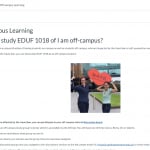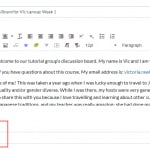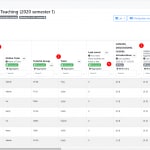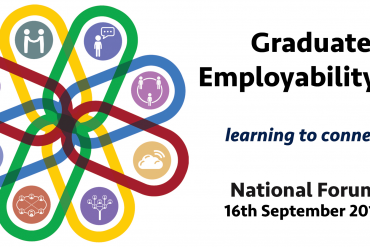With my colleagues Remy Low and Valerie Harwood, I co-coordinate EDUF1018 Education, Teachers and Teaching, a core first year unit in Education Studies. This semester, we have almost 600 students (and rising), while around 100 are affected by the Covid-19 travel ban. I was asked to share our experiences in engaging off-campus students, which center around the philosophy of keeping things simple and recognising that the delivery will be different in comparison with the on-campus experience. There have been uncertainties about technology and student welfare, as well as it being difficult to know how enrolments would track in light of the travel ban. Our strategy therefore has been largely to pare back tasks and content, and give students as much support and encouragement as possible. We recognise that many of them are working and living in very difficult circumstances, and each of us are hopeful that their studies with us might provide some hope, distraction and fulfilment as they meet these challenges. Here are some of the practical approaches that we used around unit design, supporting technologies, and assessment.
This post was contributed by Vic Rawlings.
Have an ‘Off Campus Learning’ information page on our Canvas site

Following the example from the Educational Innovation team, we established an initial page of information, which was linked directly from the EDUF1018 home page. This page ensured that students immediately were reassured that they would be able to continue their studies in an off-campus capacity while we established more concrete strategies and information. This page included tips around:
- Keeping up to date with study
- Accessing lectures and tutorials
- Meeting other students
- Attendance requirements
- VPN
Use the ‘special cohort’ function from Timetabling to identify students who are affected
This information is downloadable from the Timetabling Unit and appears as an extra ‘Special Cohort’ column in your enrolment list. In our experience, this is a good guide but is also constantly changing. We did have students identified as ‘special cohort’ via Timetabling and then they advised that they arrived before week 1 classes began, so we are adjusting these as information about individual students’ status comes through. Similarly, we have had students contact us who are affected by the travel ban but have not been listed as ‘special cohort’. We were able to establish this link through whole-unit communications asking students who had not had not been contacted about off-campus learning and were affected by the travel ban to contact us immediately. However, the special cohort function was a great starting point to be able to identify who to send special communications to about off-campus learning – it got us off the starting blocks.
Using a parallel attendance design
We determined that the best possible way to accommodate the uncertainty of the travel ban duration was to retain off-campus students in their on-campus tutorials, so that when they return to university they can easily transition into tutorial groups. At the same time, we have also placed them into off-campus tutorial/discussion groups so that they can participate in the course through online delivery.
Vic, Remy and Valerie taking charge of an off-campus group each

Remy worked to design weekly activities for our groups that utilised minimal technology (lecture and reading downloads only). Using discussion boards only released to particular Canvas ‘sections’ (see below), we established architecture in Canvas so that each one of us looked after a group of 20-30 off-campus students. Students in our groups, each week, undertake these tasks and submit a written response. As tutors, we respond to these tasks and offer students help to complete them. These weekly ‘tutorial’ tasks will also help students to complete their weekly reflection assessment tasks. The key thing is that we use the sections function in Canvas to enable students to see only their allocated discussion board, which in turn means that on-campus learners don’t see these.

An example of the week 1 discussion activities for off-campus students is in the screenshot. We wanted to make sure our students could connect with us at a human level so we included a friendly picture of ourselves, a little story about us, followed by a lot of reminders and instructions for the week. For week 1, for example, we asked students to do the following on the discussion board:
- Reflect and share – tell us a little bit about yourself and reflect on your personal experiences of teachers who have inspired you.
- Refer to the lectures and readings, and respond to a series of prompts about these, posting responses on the discussion board.
Using three systems in cooperation to track, communicate with and monitor participation of off-campus students
Using the special cohort information, plus ongoing updates from students about whether or not they are affected by the travel ban, we have been populating various systems with different information. Firstly, we have used SEAMS to bulk upload ‘section’ allocations to Canvas to establish on-campus tutorial groups (which include off-campus learners as devised in our parallel system). This allows tutors to take rolls (through the SRES, below), and for us to track attendance as usual. It also allows us to communicate directly with students and tutors as off-campus students arrive (surprisingly there is a stream of students whose status is changing from off-campus to on-campus, meaning that the parallel system is a great choice for constant change). We have also set up three ‘off-campus’ sections via SEAMS that allow us to provide specialised information and resources to off-campus students in Canvas and support them using SRES.

I cannot understate how important SRES has been throughout this process. It has allowed the sending of personalised emails to students indicating what, exactly, will be happening for their learning, pointing them to their tutor, and clearly indicating a process. I realised that without it, this challenge of identifying and communicating with students affected by the travel ban would have been met far less successfully. Indeed, my use of SRES now goes far beyond just taking attendance to using it week-to-week, and even beyond, to contact students about a range of things that are happening in their learning. It has become apparent that SRES has potential during regular business but also during unanticipated challenges to our teaching model. Now, we use SRES to do the following and more, also visible in the screenshot:
- Keep track of off-campus students
- Know which on-campus tutorial group they will join when back on campus
- Synchronise discussion engagement from Canvas
- Record attendance and any comments
- Automatically monitor participation patterns
- Send students tailored emails and see if they are reading them (not shown)
Every day I am receiving up to 15 emails from students about changing their status (either to on-campus or off-campus). Without the ability to navigate sections in SEAMS, groups in Canvas and the glue that holds our records together, SRES, this would be a far tougher endeavour.
Adjusted assessment task
We also re-designed the second assessment task, which for on-campus students is a group presentation and artefact construction. Through adapting this to be a response about how the unit teaches us about what a ‘global educator’ is, this task reflects the theory, ideology and learning outcomes of the on-campus task while adapting it for off-campus students.
The assessment adaptation was designed with the expectation that off-campus learners would likely not be able to come to campus before week five (but also with a contingency if they did). It was previously a group presentation task, where students selected, researched and presented on who they think should receive a ‘global educator of the year’ award. In addition, the groups would work together to create an artefact that represented that educator and their values. For off-campus students, we wanted to enable them to think about each weeks’ content (from lectures and tutorials) in relation to this concept of leading educators, yet we knew that they would need to do this task individually and potentially without any usage of technology. As such, we redesigned it to be in three parts, and due at the end of week 5.
We provided students with a worked example, put together by Remy and based on a Chinese Education Foundation to give some additional relevance. This will help orientate students on what to do. If students were able to return after groups were formed, yet before week 5, they could still complete this task. This gave us assurance that whatever mode they would work in, they would be able to have a relevant task to do that still suited the course content.
Use of WeChat to troubleshoot with and communicate with individual students in real time
Establishing unit architecture has not been without flaws, and at times students have been unable to access certain information. Through using WeChat we have been able to establish contact with individual students when they need assistance and work with them in real time to solve problems. I have found this to be a great platform to find out what students are really thinking and what support they need – it’s my experience that they are far more ready to communicate in this form than email, and that it is standard practice for them to use WeChat with their teaching staff. Using it has been another great way to connect with them and show our care for them.
How are students finding it?
All of this has been a challenging yet exceptionally rewarding undertaking. I feel that the students are responding well to our communications, especially those through SRES and subsequent email/WeChat exchanges. The main message that we wanted to get across is that we care about them, we empathise with their situation, and that we are doing everything we can to support their learning. I wanted to anonymously share part of some feedback we received, which makes us think that this message is getting across:
Hello my dear Tutor, I’m really anticipated to receive your greeting during this special period . How nice you are~Thank you for sending the updated information to me and thank you for caring about me so much. I am very glad to choose your course and meet you such a caring mentor.
In the whirlwind of emails, messages, phone calls and meetings around our strategies for this semester, words like this really drive home that our actions – however digital or robotic they seem – can have a genuine impact on our students, no matter how far away they are.





